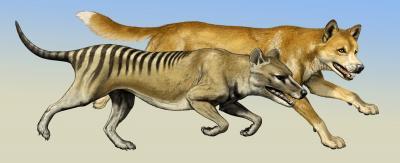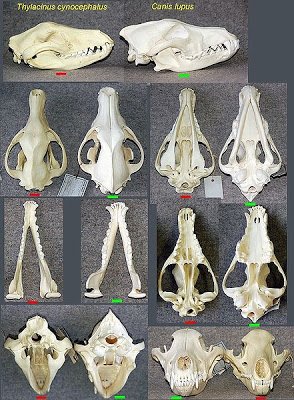just look at dogs to wolves
Grey wolf & placental canids Vs Tasmanian wolf/thylacine:
Thylacinus cynocephalus, Greek for "dog-headed pouched one") was the largest known carnivorous marsupial of modern times. It is commonly known as the Tasmanian tiger (because of its striped back) or the Tasmanian wolf. Native to continental Australia, Tasmania and New Guinea, it is thought to have become extinct in the 20th century. It was the last extant member of its family, Thylacinidae; specimens of other members of the family have been found in the fossil record dating back to the early Miocene.
The gray wolf or grey wolf (Canis lupus) is a species of canid native to the wilderness and remote areas of North America, Eurasia, and North Africa.
Evolutionary biologists believe that these two different species have completely separate evolutionary histories. (Since the continent of Australia and the islands around it split off from Gondwanaland (the supercontinent that is supposed to be the originator of Africa, Antarctica, Australia, and South America) the link between placental and marsupial mammals is considered to have been broken, and at that time there were no wolves).
But the interesting thing is that the skeletal structure of the Tasmanian wolf is nearly identical to that of the North American wolf. Their skulls bear an extraordinary degree of resemblance to each other.
The skulls of the Thylacine (left) and the Grey Wolf,
Canis lupus, are similar, although the species are only very distantly related according to neo-darwinism. Caninae that led to present-day
canids (wolves, foxes, coyotes, jackals, and domestic dogs)
appeared only (about
10-0 Mya) while
the last imaginary common ancestor was about
160 Mya !!!
The obstacle:
A most striking factor for consideration is the existence of
numerous marsupial and placental mammals that are virtually identical to one another with the exception of the distinctions in their reproductive systems.
One of the most concrete examples of such an obstacle in the path of Neo-darwinian theory is that there are "pairs" in placentals and marsupials which are nearly the same.
In other words, according to the theory of evolution,
mutations completely independent of each other must have produced these creatures "by chance" twice! This reality is a question that will give Darwinists problems even worse than dizzy spells.
Extraordinary resemblances and similar organs like these, which evolutionary biologists cannot accept as examples of "homology," show that homology
does not constitute any evidence for the thesis of evolution from a common ancestor.
Ad hoc:
An ad hoc explanation is an unfalsifiable explanation provided in an effort to account for an inconsistency in a theory.
For example:
A child says that he turned his homework in to the teacher. The teacher then confronts him with the fact that the homework is not in the box. The child responds, "Somebody must have stolen it!" The child has no evidence to support the allegation that someone stole the homework -- he has simply manufactured an unfalsifiable explanation to deal with a difficulty in his story.
Ad hock
In response, evolutionists say that these organs are
not "homologous" (in other words, from a common ancestor), but that they are "analogous" (very similar to each other, although there is no evolutionary connection between them). However,
the question of which category they will put an organ into, homologous or analogous, is answered totally in line with the theory of evolution's preconceptions.
The explanation is ad hoc in the sense that it was
invented in order to explain away a difficulty in a theory, and is not itself supported by experimental evidence.
And this shows that
the Darwinist claim based on resemblances is completely unscientific. The only thing Darwinists do is to try to interpret new discoveries in accordance with a dogmatic evolutionary preconception.
http://evolutionfactormyth.blogspot.com/2013/05/the-problem-of-marsupials-homology.html

